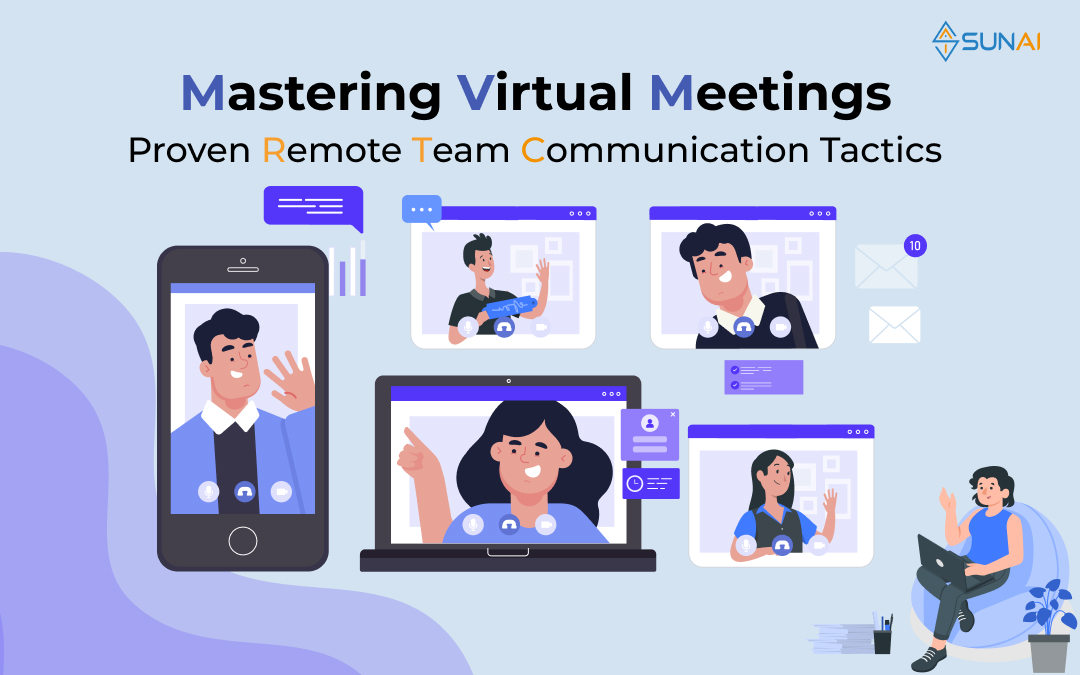In the digital age, remote work has become a prevalent and transformative trend. The ability to work from anywhere has changed the way we approach our professional lives. With remote work on the rise, it’s essential to adapt and adopt effective communication strategies to ensure the success of remote teams. One of the key pillars of remote team communication is virtual meetings.
The Rise Of Remote Work and Its Relevance
The 21st century has witnessed a significant shift in the way businesses operate. Traditional office environments are increasingly being replaced by remote work setups. The advent of advanced technology and the Internet has made it possible for employees to collaborate and work together from different corners of the globe.
Remote work offers numerous advantages for both employers and employees. It allows for greater flexibility, better work-life balance, and access to a global talent pool. As a result, the workforce of the future is expected to be even more remote than it is today. According to a report from FlexJobs, remote work has grown by 159% since 2005, and 4.7 million people in the United States were working remotely before the COVID-19 pandemic.
Why Virtual Meetings Are Essential in Today’s Digital World

With the rise of remote work, virtual meetings have become an indispensable tool for maintaining effective team communication. In a world where physical proximity is no longer a requirement, it bridge the gap, enabling teams to collaborate seamlessly. Here are a few reasons why virtual meetings are so crucial:
Real-Time Collaboration: Virtual meetings allow teams to communicate in real-time, fostering quicker decision-making and problem-solving. No more waiting for emails or delayed responses.
Personal Connections: Video conferences enable participants to see each other, which helps build a sense of community and personal connections. This is especially important for remote teams, as it can combat feelings of isolation.
Global Reach: With virtual meetings, team members can be located anywhere in the world. This offers access to a broader talent pool and diverse perspectives, which can lead to more innovative solutions.
Reduced Costs: Virtual meetings eliminate the need for travel and associated expenses, making them a cost-effective solution for businesses.
Increased Productivity: Meetings can be more focused and efficient, with the ability to share screens, documents, and data during the discussion.
In the next part of this blog, we will delve deeper into tips for running better virtual meetings, the top virtual meeting tools, and how it enhance team communication. Stay tuned to discover how mastering virtual meetings can lead to successful remote team management.
Tips for Successfully Running Virtual Meetings

Setting Clear Meeting Objectives and Agendas
One of the primary keys to a successful virtual meeting is having a clear objective and a well-structured agenda. Without a clear purpose, meetings can easily become unproductive and unfocused, leading to disengagement and frustration among participants.
Here are some tips for setting clear meeting objectives and agendas:
Define the Purpose: Before scheduling a virtual meeting, ask yourself why it’s necessary. Is it for brainstorming, decision-making, project updates, or team building? Clearly define the meeting’s purpose.
Create an Agenda: Develop a detailed agenda outlining what topics will be covered, who will be responsible for each section, and how much time will be allocated to each. Share the agenda with participants in advance.
Send Out Pre-Reading Materials: If there are documents, reports, or materials to be discussed during the meeting, distribute them beforehand. This allows participants to prepare and contribute more effectively.
Engaging Participants and Promoting Active Participation
Keeping participants engaged during a virtual meeting is crucial. The lack of physical presence can make it easier for individuals to become disengaged. To maintain a high level of engagement, consider the following:
Encourage Interaction: Invite all participants to actively contribute to the discussion. Encourage questions, feedback, and comments throughout the meeting.
Use Video: Whenever possible, encourage participants to turn on their video cameras. Seeing each other’s faces fosters a sense of connection and engagement.
Rotate Roles: Assign different roles to participants, such as a timekeeper, note-taker, or discussion leader. This keeps everyone involved and responsible for the meeting’s success.
Also Read Remote Tallent Aquisition: How to Attract and Retain Top Software Developers
Managing Meeting Time Effectively
Time management is crucial in virtual meetings. To ensure that meetings remain efficient and productive, follow these time management tips:
Stick to the Agenda: Respect the time allocated for each agenda item. If a topic needs more discussion, consider scheduling a separate meeting.
Set a Time Limit: Determine a meeting duration and stick to it. Shorter, focused meetings are often more effective than long, drawn-out ones.
Use Technology Wisely: Leverage time-tracking features in virtual meeting tools to keep meetings on schedule.
Addressing Common Virtual Meeting Challenges
Virtual meetings come with their own set of challenges, such as technical issues, interruptions, and multitasking. Here’s how to address some of these common challenges:
Technical Readiness: Ensure that all participants are familiar with the virtual meeting platform and have access to the necessary technology. Conduct test runs if needed.
Minimize Distractions: Encourage participants to find a quiet, distraction-free environment for the meeting. Advise them to mute notifications and avoid multitasking.
Managing Time Zones: If your team spans multiple time zones, consider rotating meeting times to accommodate everyone. Use scheduling tools that display multiple time zones for clarity.
Encouraging Feedback and Continuous Improvement
After the virtual meeting, seek feedback from participants. This can be done through post-meeting surveys or open discussions. Feedback helps identify areas for improvement and ensures that future meetings are even more effective.
In the next part of this blog, we will explore the top virtual meeting tools that can enhance your remote team communication and discuss how it can lead to more effective remote team management. Stay tuned for actionable insights and recommendations to help you master virtual meetings.
Top Virtual Meeting Tools
Effective virtual meetings require the right tools and technology. The market is filled with various virtual meeting platforms, each offering a unique set of features. Let’s take a closer look at some of the top virtual meeting tools to consider for your remote communication:
Zoom

When choosing a virtual meeting tool, consider your specific team’s needs, including the size of your team, budget constraints, and the need for integrations with other software. Most tools offer free trials, allowing you to test their features before committing to a subscription.
Microsoft Teams

Part of the Microsoft 365 suite, Microsoft Teams combines video conferencing, chat, and file sharing into one platform. It’s a great choice for organizations already using Microsoft products. Teams also provide a range of third-party app integrations.
Cisco Webex

Cisco Webex is a secure platform that caters to businesses of all sizes. It offers features like high-definition video, file sharing, and recording. Webex is renowned for its end-to-end encryption, making it a suitable choice for sensitive information sharing.
Google Meet

Google Meet is part of the Google Workspace (formerly G Suite) and integrates seamlessly with Google Calendar and Gmail. It’s known for its simplicity and reliability, with features like screen sharing and real-time captions.
Slack

Slack is a messaging app that also supports video calls. It’s popular for its team communication capabilities, offering channels for different topics and easy file sharing. Slack integrations with other apps make it a versatile tool for remote team communication.
GoToMeeting

GoToMeeting is a user-friendly platform that offers features like screen sharing, recording, and drawing tools. It’s suitable for small to large teams and provides integrations with popular productivity apps.
When choosing a virtual meeting tool, consider your specific team’s needs, including the size of your team, budget constraints, and the need for integrations with other software. Most tools offer free trials, allowing you to test their features before committing to a subscription.
How Virtual Meetings Enhance Remote Team Communication

Now that we’ve discussed the tips and top tools for virtual meetings, let’s dive into how it can enhance remote team communication:
Real-Time Interaction: Virtual meetings enable face-to-face communication, making it easier to read facial expressions and body language. This fosters a stronger sense of connection and understanding among team members.
Collaborative Tools: Many virtual meeting platforms come with built-in collaborative features like shared whiteboards, document sharing, and real-time editing. These tools promote active participation and idea sharing.
Increased Engagement: Visual engagement, such as screen sharing and video calls, can help keep participants attentive and engaged. This is especially valuable for preventing distractions that often occur during audio-only calls.
Global Reach: Remote teams can consist of members from different regions and time zones. Virtual meetings accommodate this diversity, allowing team members to participate from anywhere in the world.
Effective Decision-Making: Virtual meetings provide a forum for team members to discuss important matters and make decisions together. This collaborative decision-making process can lead to more informed and effective outcomes.
Building Team Culture: Regular virtual meetings can contribute to a strong team culture. Team members get to know each other on a personal level, fostering a sense of unity and belonging.
In the final part of this blog, we will discuss proven tactics for effective remote team communication, how to overcome challenges, and how to measure the impact of virtual meetings on your remote team management. Stay tuned for actionable insights to help you master the art of virtual meetings for remote team success.
Proven Tactics for Effective Remote Team Communication
Now that we understand the significance of virtual meetings and have explored the tools that facilitate remote team communication, let’s delve into some proven tactics to enhance the effectiveness of your remote team communication:
Utilizing Virtual Meetings as a Communication Bridge
Virtual meetings serve as a bridge between remote team members. They provide a platform for real-time communication, which is essential for clarifying doubts, discussing project updates, and addressing challenges. Here are some tactics to maximize the effectiveness of virtual meetings:
Regular Check-Ins: Schedule regular virtual meetings, whether they are daily stand-ups, weekly team meetings, or monthly reviews. Consistency in communication is key to building trust and transparency.
Interactive Discussions: Encourage team members to actively participate in meetings by sharing their insights, ideas, and concerns. Interactive discussions can lead to better decision-making and problem-solving.
Personal Connection: Begin meetings with a brief check-in on a personal level. This can help team members connect on a more human level and build stronger relationships.
Strategies for Clear and Concise Communication During Virtual Meetings
Clear communication is the backbone of any successful virtual meeting. Here are some strategies to ensure your team’s communication is effective:
- Use Visual Aids: Utilize visual aids, such as slides or digital whiteboards, to make your points clearer. Visuals can enhance understanding, especially when discussing complex topics.
- Effective Questioning: Encourage team members to ask questions for clarification. This promotes active engagement and ensures that everyone is on the same page.
- Summarize Key Points: At the end of the meeting, summarize the key takeaways and action items. This helps reinforce what was discussed and provides a clear path forward.
Promoting Transparency and Accountability in Remote Team
Transparency and accountability are crucial for remote team success. Here’s how you can foster these qualities:
- Documenting Meeting Minutes: Assign someone to take meeting minutes and share them with the team after each meeting. This documentation ensures that everyone is aware of what was discussed and the agreed-upon action items.
- Setting Expectations: Clearly define roles and responsibilities within the team. Make sure every team member understands their tasks and deadlines.
- Regular Progress Updates: Encourage team members to provide regular updates on their tasks and projects. This keeps everyone informed and accountable.
Overcoming Virtual Meeting Challenges
While virtual meetings offer numerous benefits, they also come with their own set of challenges. Here’s how to tackle some common issues:
Technical Hiccups: To minimize technical problems, test your equipment and internet connection before the meeting. Have a backup plan in case of technical difficulties.
Time Zone Differences: If your team spans different time zones, consider rotating meeting times to ensure fairness. Use scheduling tools that display multiple time zones for clarity.
Distractions: Advise team members to find a quiet, distraction-free environment for virtual meetings. Suggest muting notifications and avoiding multitasking during the meeting.
Also Read Remote Tallent Aquisition: How to Attract and Retain Top Tallent Software Developers
Measuring the Impact of Virtual Meetings
Assessing the impact of virtual meetings is essential for continuous improvement. Here are some key performance indicators (KPIs) to measure success:
Meeting Attendance: Monitor how many team members attend virtual meetings consistently. Low attendance may indicate engagement issues.
Meeting Duration: Track the average meeting duration. If meetings consistently run over the allotted time, it may indicate inefficiencies.
Action Item Completion: Measure the completion rate of action items discussed in meetings. This reflects the effectiveness of your team’s follow-through.
Participant Feedback: Collect feedback from participants after each meeting to gauge their satisfaction and identify areas for improvement.
In the final part of this blog, we will summarize the key takeaways, reinforce the importance of embracing virtual meetings in today's remote work landscape, and encourage readers to apply the insights and tactics discussed to achieve better remote team communication. Stay tuned for the conclusion.
Conclusion
In this comprehensive blog, we’ve explored the world of virtual meetings and how they play a pivotal role in remote team communication and management. At SUNAI, where we manage a team of 20+ remote employees, we’ve experienced firsthand the transformative power of virtual meetings in enhancing our remote work operations.
As a company that specializes in remote work solutions, SUNAI has harnessed the potential of virtual meetings to its fullest extent. We’ve employed these meetings to foster real-time interaction, provide collaborative tools, and increase engagement among our remote team members. Our experience has shown that virtual meetings not only bridge geographical gaps but also create a sense of unity and shared purpose.
We understand the challenges that come with remote work, including technical hiccups, time zone differences, and distractions, and we’ve successfully overcome them by implementing the strategies and tips we’ve shared in this blog. At SUNAI, we prioritize clear and concise communication during virtual meetings, promoting transparency and accountability to ensure our remote team’s success.
For those seeking a reliable and experienced partner in remote team communication, SUNAI is the right choice. Our track record with 20+ remote employees is a testament to our expertise in the field. We’ve not only embraced virtual meetings as a core component of our team communication strategy but have also leveraged them to improve collaboration, enhance decision-making, and cultivate a thriving team culture.
As remote work continues to evolve and expand, mastering virtual meetings will be an indispensable skill for effective remote team management. We encourage you to apply the insights from this blog, experiment with different virtual meeting tools, and continually measure the impact of virtual meetings on your remote team’s performance. SUNAI is here to support you on your journey to elevate your remote team communication and achieve success in the ever-evolving landscape of remote work.
Thank you for reading, and we hope that the information provided here empowers you to unlock the full potential of virtual meetings, just as we have at SUNAI. Join us in shaping the future of remote work and experience the difference that effective virtual meetings can make.







0 Comments